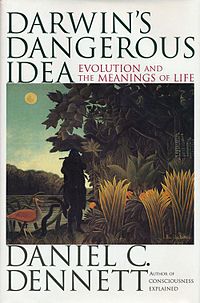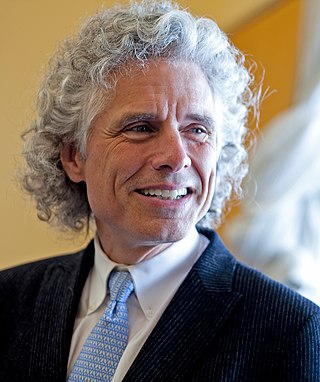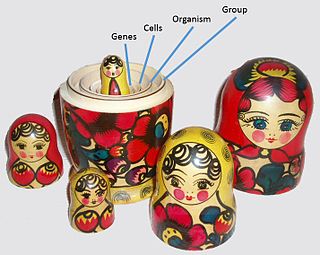
The clitoris is a female sex organ present in mammals, ostriches and a limited number of other animals. In humans, the visible portion – the glans – is at the front junction of the labia minora, above the opening of the urethra. Unlike the penis, the male homologue (equivalent) to the clitoris, it usually does not contain the distal portion of the urethra and is therefore not used for urination. In most species, the clitoris lacks any reproductive function. While few animals urinate through the clitoris or use it reproductively, the spotted hyena, which has an especially large clitoris, urinates, mates, and gives birth via the organ. Some other mammals, such as lemurs and spider monkeys, also have a large clitoris.

Darwin's Dangerous Idea: Evolution and the Meanings of Life is a 1995 book by the philosopher Daniel Dennett, in which the author looks at some of the repercussions of Darwinian theory. The crux of the argument is that, whether or not Darwin's theories are overturned, there is no going back from the dangerous idea that design might not need a designer. Dennett makes this case on the basis that natural selection is a blind process, which is nevertheless sufficiently powerful to explain the evolution of life. Darwin's discovery was that the generation of life worked algorithmically, that processes behind it work in such a way that given these processes the results that they tend toward must be so.

Orgasm, or sexual climax, is the sudden discharge of accumulated sexual excitement during the sexual response cycle, resulting in rhythmic, involuntary muscular contractions in the pelvic region characterized by sexual pleasure. Experienced by males and females, orgasms are controlled by the involuntary or autonomic nervous system. They are usually associated with involuntary actions, including muscular spasms in multiple areas of the body, a general euphoric sensation, and, frequently, body movements and vocalizations. The period after orgasm is typically a relaxing experience, attributed to the release of the neurohormones oxytocin and prolactin as well as endorphins.

In evolutionary biology, punctuated equilibrium is a theory that proposes that once a species appears in the fossil record, the population will become stable, showing little evolutionary change for most of its geological history. This state of little or no morphological change is called stasis. When significant evolutionary change occurs, the theory proposes that it is generally restricted to rare and geologically rapid events of branching speciation called cladogenesis. Cladogenesis is the process by which a species splits into two distinct species, rather than one species gradually transforming into another.

Stephen Jay Gould was an American paleontologist, evolutionary biologist, and historian of science. He was one of the most influential and widely read authors of popular science of his generation. Gould spent most of his career teaching at Harvard University and working at the American Museum of Natural History in New York. In 1996, Gould was hired as the Vincent Astor Visiting research professor of biology at New York University, after which he divided his time teaching between there and Harvard.

The Selfish Gene is a 1976 book on evolution by the ethologist Richard Dawkins, in which the author builds upon the principal theory of George C. Williams's Adaptation and Natural Selection (1966). Dawkins uses the term "selfish gene" as a way of expressing the gene-centred view of evolution, popularising ideas developed during the 1960s by W. D. Hamilton and others. From the gene-centred view, it follows that the more two individuals are genetically related, the more sense it makes for them to behave cooperatively with each other.

Steven Arthur Pinker is a Canadian-American cognitive psychologist, psycholinguist, popular science author, and public intellectual. He is an advocate of evolutionary psychology and the computational theory of mind.

Female ejaculation is characterized as an expulsion of fluid from the Skene's gland at the lower end of the urethra during or before an orgasm. It is also known colloquially as squirting, although research indicates that female ejaculation and squirting are different phenomena, squirting being attributed to a sudden expulsion of liquid that partly comes from the bladder and contains urine.

Richard Charles Lewontin was an American evolutionary biologist, mathematician, geneticist, and social commentator. A leader in developing the mathematical basis of population genetics and evolutionary theory, he applied techniques from molecular biology, such as gel electrophoresis, to questions of genetic variation and evolution.

Shere Hite was an American-born German sex educator and feminist. Her sexological work focused primarily on female sexuality. Hite built upon biological studies of sex by Masters and Johnson and by Alfred Kinsey. She also referenced theoretical, political and psychological works associated with the feminist movement of the 1970s, such as Anne Koedt's essay The Myth of the Vaginal Orgasm. She renounced her United States citizenship in 1995 to become German.

A unit of selection is a biological entity within the hierarchy of biological organization that is subject to natural selection. There is debate among evolutionary biologists about the extent to which evolution has been shaped by selective pressures acting at these different levels.

Eohippus is an extinct genus of small equid ungulates. The only species is E. angustidens, which was long considered a species of Hyracotherium. Its remains have been identified in North America and date to the Early Eocene.

Eight Little Piggies (1993) is the sixth volume of collected essays by the Harvard paleontologist Stephen Jay Gould. The essays were selected from his monthly column "The View of Life" in Natural History magazine, to which Gould contributed for 27 years. The book covers topics that are common to Gould's writing in a discursive manner, including evolution and its teaching, science biography, probabilities, and common sense.

The Structure of Evolutionary Theory (2002) is Harvard paleontologist Stephen Jay Gould's technical book on macroevolution and the historical development of evolutionary theory. The book was twenty years in the making, published just two months before Gould's death. Aimed primarily at professionals, the volume is divided into two parts. The first is a historical study of classical evolutionary thought, drawing extensively upon primary documents; the second is a constructive critique of the modern synthesis, and presents a case for an interpretation of biological evolution based largely on hierarchical selection, and the theory of punctuated equilibrium.
The Panda's Thumb is a blog on issues of creationism and evolution from a mainstream scientific perspective. In 2006, Nature listed it as one of the top five science blogs, and Mark Pallen has called it "the definitive blog on the evolution versus creationism debate".
Darwinian literary studies is a branch of literary criticism that studies literature in the context of evolution by means of natural selection, including gene-culture coevolution. It represents an emerging trend of neo-Darwinian thought in intellectual disciplines beyond those traditionally considered as evolutionary biology: evolutionary psychology, evolutionary anthropology, behavioral ecology, evolutionary developmental psychology, cognitive psychology, affective neuroscience, behavioural genetics, evolutionary epistemology, and other such disciplines.
Elisabeth Anne Lloyd is an American philosopher of science specialising in the philosophy of biology. She is currently Distinguished Professor of History and Philosophy of Science and Medicine - as well as Adjunct Professor of biology - at Indiana University, Bloomington, affiliated faculty scholar at the Kinsey Institute for Research in Sex, Gender and Reproduction and Adjunct Faculty at the Center for the Integrative Study of Animal Behavior.

Evolutionary thought, the recognition that species change over time and the perceived understanding of how such processes work, has roots in antiquity—in the ideas of the ancient Greeks, Romans, Chinese, Church Fathers as well as in medieval Islamic science. With the beginnings of modern biological taxonomy in the late 17th century, two opposed ideas influenced Western biological thinking: essentialism, the belief that every species has essential characteristics that are unalterable, a concept which had developed from medieval Aristotelian metaphysics, and that fit well with natural theology; and the development of the new anti-Aristotelian approach to modern science: as the Enlightenment progressed, evolutionary cosmology and the mechanical philosophy spread from the physical sciences to natural history. Naturalists began to focus on the variability of species; the emergence of palaeontology with the concept of extinction further undermined static views of nature. In the early 19th century prior to Darwinism, Jean-Baptiste Lamarck (1744–1829) proposed his theory of the transmutation of species, the first fully formed theory of evolution.

The Evolution of Human Sexuality is a 1979 book about human sexuality by the anthropologist Donald Symons, in which the author discusses topics such as human sexual anatomy, ovulation, orgasm, homosexuality, sexual promiscuity, and rape, attempting to show how evolutionary concepts can be applied to humans. Symons argues that the female orgasm is not an adaptive trait and that women have the capacity for it only because orgasm is adaptive for men, and that differences between the sexual behavior of male and female homosexuals help to show underlying differences between male and female sexuality. In his view, homosexual men tend to be sexually promiscuous because of the tendency of men in general to desire sex with a large number of partners, a tendency that in heterosexual men is usually restrained by women's typical lack of interest in promiscuous sex. Symons also argues that rape can be explained in evolutionary terms and feminist claims that it is not sexually motivated are incorrect.

Feminist philosophy of science is a branch of feminist philosophy that seeks to understand how the acquirement of knowledge through scientific means has been influenced by notions of gender identity and gender roles in society. Feminist philosophers of science question how scientific research and scientific knowledge itself may be influenced and possibly compromised by the social and professional framework within which that research and knowledge is established and exists. The intersection of gender and science allows feminist philosophers to reexamine fundamental questions and truths in the field of science to reveal how gender biases may influence scientific outcomes. The feminist philosophy of science has been described as being located "at the intersections of the philosophy of science and feminist science scholarship" and has attracted considerable attention since the 1980s.


















